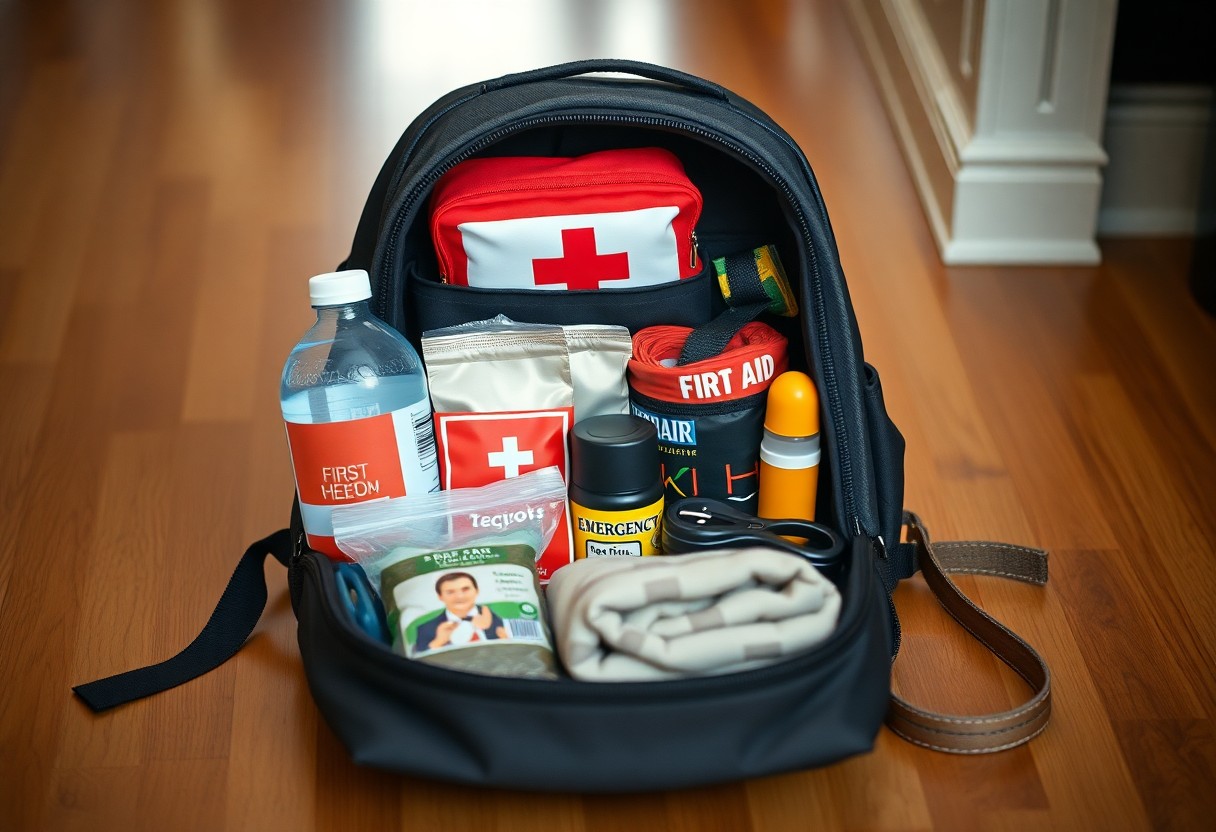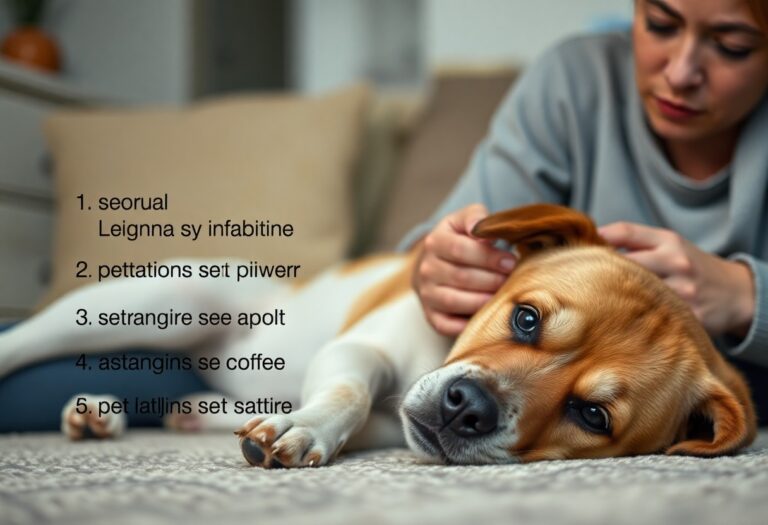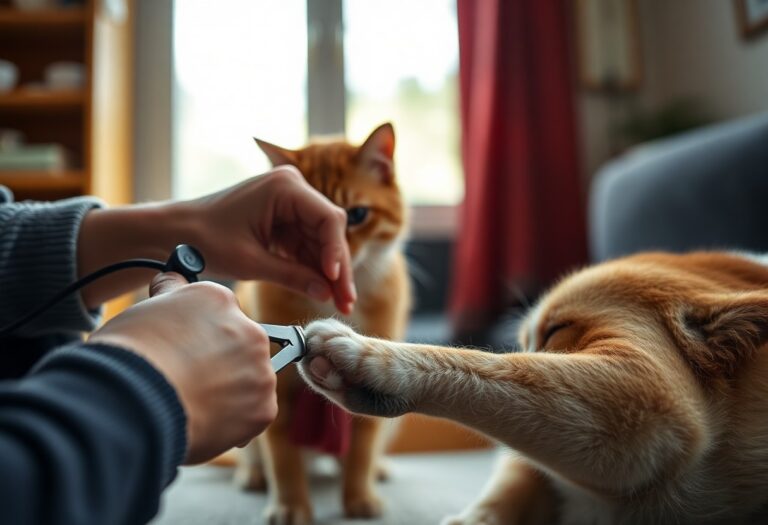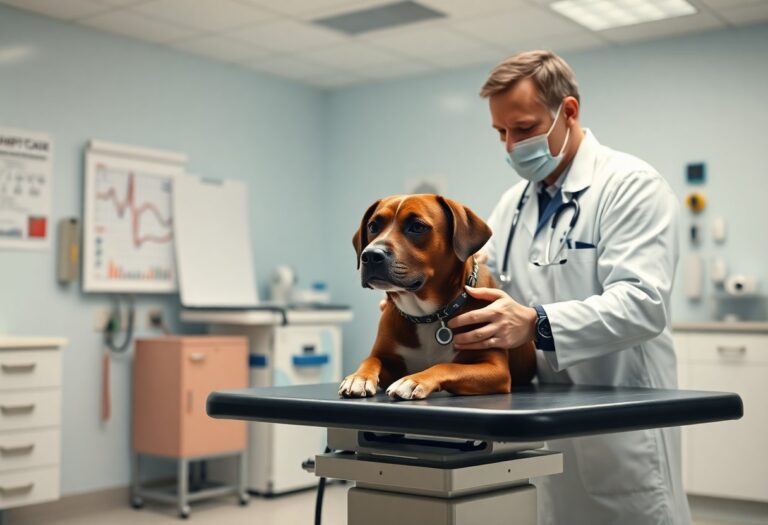Many pet owners underestimate the importance of having a well-prepared emergency kit for their furry friends. In the event of a disaster, having important items on hand can make a significant difference in your pet’s safety and well-being. This guide will help you identify what you should include in your kit, ensuring you’re ready to address any potential dangers that may arise. From food and medications to identification and first aid supplies, being proactive can lead to a positive outcome for you and your beloved pet in times of crisis.
Kit your pet out with necessary supplies to ensure their safety in any emergency situation. Preparing vital necessities, such as food, water, a first aid kit, and important documents, can make a significant difference in a crisis. Don’t forget to include your pet’s medications and a comfort item, like a favorite toy, to help reduce anxiety. By planning ahead, you can provide peace of mind for both you and your furry friend when it matters most.
Must-Have Supplies for Your Pet’s Safety
First Aid Essentials
A well-stocked first aid kit is a non-negotiable component of your pet emergency kit. Start with the basics like adhesive bandages, sterile gauze, and medical tape to tend to minor cuts and scrapes. Include antiseptic wipes suitable for pets and a digital thermometer to monitor temperature, as some pets may require urgent veterinary attention if they develop a fever. A pair of tweezers can help remove ticks or splinters, while a muzzle, though not for abusive purposes, may be necessary if your pet is in pain and could bite. Finally, keep a list of emergency contact numbers, including your veterinarian and a 24-hour animal poison control hotline, to guide you in a crisis.
Emergency Food and Water Provisions
In the event of an emergency, having a supply of non-perishable food tailored to your pet’s dietary needs ensures that they remain nourished and energized. Consider storing dry kibble or canned food that doesn’t require refrigeration; make sure to rotate these supplies regularly to prevent spoilage. For dogs and cats, include at least a three-day supply of food in your kit. Water is equally necessary – a general rule is to provide one ounce of water per pound of body weight each day, so stock appropriate containers that can keep your pet hydrated over extended periods of time.
In scenarios like natural disasters or unexpected evacuations, availability of clean water can quickly become a challenge. To prepare, consider using water bottles or collapsible bowls that are easy to transport. Alternatively, portable water purification systems can help ensure your pet has access to drinkable water, taking that extra weight off your shoulders knowing your furry friend won’t go thirsty if separated from regular sources. Always check that your provisions are suited for your pet’s specific dietary restrictions, ensuring you can maintain their health even in difficult times.
The Must-Have Essentials for Every Pet Emergency Kit
Food and Water Supplies
Your pet’s sustenance is a top priority during an emergency, so having ample food and water supplies in their kit is non-negotiable. Always include a minimum of three days’ worth of food that meets their specific dietary needs. If your pet has any allergies or sensitivities, ensure that the food is suitable for them. Additionally, pack portable water containers or bottles, along with at least one gallon of water per pet per day. This preparation ensures that your pet has access to clean drinking water, which is vital for their health.
If your pet is on a special diet or prefers a specific brand, stock up on canned or dry food that they are accustomed to. Include a can opener if necessary, and rotate these supplies regularly to keep everything fresh. Having a collapsible bowl in the kit allows you to easily feed your pet on the go, making meal times less stressful and more manageable during an emergency.
First Aid Supplies
An effective pet emergency kit must contain vital first aid supplies to manage injuries or unexpected health issues. Start by including items such as adhesive bandages, sterile gauze pads, antiseptic wipes or solutions, and medical tape. Adding a digital thermometer can help you monitor your pet’s temperature during stressful situations, as it can indicate if they’re experiencing illness. Don’t forget a set of tweezers for removing splinters or ticks, and a pair of scissors for cutting bandages or clothing in case of emergencies.
Keep in mind that pet-specific first aid books or guides can provide valuable guidance during emergencies, especially since treatments can differ from those for humans. You might also consider incorporating a pet first-aid kit manual that details symptoms to watch for and basic care instructions, which further enhances your readiness.
Important Documentation and Identification
Health Records and Vaccination Papers
Having your pet’s health records and vaccination papers on hand can significantly streamline veterinary care during emergencies. Make copies of these documents and keep them in a waterproof container within your emergency kit. This includes information on your pet’s vaccination history, recent medical treatments, and any known allergies or chronic conditions. If you face an unplanned veterinary visit, you’ll ensure that the staff have all the necessary information to provide the best care possible for your pet.
Aside from aiding emergency medical treatment, health records can also be invaluable if you need to travel with your pet or stay in temporary housing, as many places require proof of vaccination against diseases like rabies. Ensure that the documents are updated regularly to reflect the latest vaccinations or treatments your pet receives. You might consider creating a digital backup stored securely in the cloud as an added measure against loss.
Microchip Information and ID Tags
Microchips serve as a permanent form of identification for your pet, making them a reliable safeguard against losing your furry friend during chaotic situations. When your pet is microchipped, a small device is implanted just under the skin that provides a unique ID number. This number can be scanned at shelters or veterinary offices, linking your pet back to you using the information provided during registration. It’s wise to ensure that your contact details are up to date with the microchip registry, as many pets are found thanks to this system every year.
In addition to microchips, having ID tags on your pet’s collar ensures that anyone who finds your lost animal can quickly contact you. These tags should include your pet’s name, your phone number, and potentially your address for added security. Always choose a collar that fits snugly yet comfortably, and inspect it regularly to ensure it isn’t worn down or damaged. This dual approach of microchips and ID tags maximizes your chances of reuniting with your pet should the unexpected occur.
It’s worth noting the combined effectiveness of both methods. While microchips provide a permanent solution, ID tags offer immediate identification, which is especially crucial in hectic emergency situations. You can greatly enhance the safety of your pet by investing the time and effort into ensuring that both forms of identification are in place and properly maintained.
Critical Documentation to Keep Within Reach
Medical Records and Vaccination History
Your pet’s medical records and vaccination history are necessary components of their emergency documentation. Should you need to visit a new veterinarian in an urgent situation, having this information readily available can make a significant difference in their care. Include records of any pre-existing conditions, allergies, or medications your pet is currently taking. It’s wise to keep a summarized version of this information in your emergency kit, alongside copies of the actual documentation for easy reference. If your pet requires specific treatments or medications, having a list will aid in ensuring continuous care, even in unpredictable circumstances.
Identification and Contact Information
Identification is vital if your pet goes missing during an emergency. You should have a copy of your pet’s ID tags, microchip registration details, and your contact information readily available. If your pet is lost, shelters or veterinarians can access this information, which can help get your furry friend back home as quickly as possible. Include details such as your address, phone numbers, and email, as well as alternative contacts who can assist in your absence. This precaution not only streamlines communication but also helps minimize the stress associated with keeping track of your pet during a crisis.
Including these vital elements in your pet emergency kit ensures that you can provide quick access to important information when it matters most. A well-organized folder or a waterproof pouch containing these documents can save time and reduce the chaos you may face in an emergency situation. Keeping your pet’s identification and medical documentation up to date, combined with easy access to these documents, protects your pet’s well-being and fosters peace of mind. Aim to reassess your kit regularly; even minor updates can make all the difference in an unexpected event.
Tailored Items for Specific Pet Needs
Gear for Dogs and Cats
Your canine companions and felines come with their own set of requirements during emergencies. Pack a sturdy leash and a carrier for your dog, ensuring that the leash is at least six feet long and made of durable material to prevent escapes in chaotic situations. For cats, a well-ventilated, secure carrier is vital for transportation, along with a snug blanket that offers comfort during stressful times. Additionally, including a muzzle can come in handy to prevent biting if your dog becomes anxious. Keep a spare collar with an ID tag on hand, which should include your contact information and any medical needs your pet may have.
Having a supply of food and water is just as vital. At least three days’ worth of your pet’s regular food—preferably in sealed, easy-to-carry containers—should be in your kit. Don’t forget collapsible water bowls and an extra supply of fresh water. Preparing a first aid kit tailored for your furry friends is equally beneficial; it should include items like antiseptic wipes, tweezers for splinter removal, and a basic pet-specific instruction manual for emergencies. This thoughtful preparation can save time and reduce panic during a disaster.
Special Considerations for Small Animals and Exotic Pets
Small animals like rabbits, guinea pigs, or ferrets, along with exotic pets such as reptiles and birds, require specialized attention. The emergency kit for these pets should include their usual bedding and a secure transport cage that allows for adequate ventilation. Small animals may benefit from a familiar stuffed toy or blanket for comfort, while birds may need a cover for their cage as they can become easily stressed. Additionally, having a small supply of their favorite treats can help keep them calm during an emergency situation.
For reptiles, maintaining proper temperature is vital, so you should consider including a portable heat source and a water dish that is appropriate for their size. Likewise, exotic pets often have specific dietary needs which require unique food supplies. Including a first aid kit with the right medications or a list of veterinary contacts equipped to handle such animals can significantly help if any health issues arise. Catering to these unique requirements ensures that all pets remain as comfortable and secure as possible during emergencies.
Tools for Emergency Communication and Navigation
Emergency Contacts List
Your emergency contacts list plays a vital role during high-stress situations. In your kit, include a printed list of necessary phone numbers, such as your veterinarian, local animal shelters, and emergency services. Make sure to list contact details for family members or friends who can help take care of your pet or provide assistance during an evacuation. Ideally, the list should be laminated or housed in a waterproof bag to withstand outdoor conditions, ensuring it remains intact even during a disaster.
Consider keeping an electronic copy of this list on your smartphone or a cloud service, accessible even if you lose physical copies in the chaos. You can update the list regularly, particularly if you change vet clinics or move to a new area, ensuring you always have the latest information at hand. Your pets depend on you for their safety, so having these contacts available could make all the difference in a critical situation.
Maps and Local Shelter Information
In case you need to evacuate your home, having accurate maps and detailed information on local animal shelters is invaluable. Gather several maps for your area, highlighting routes to local shelters, veterinary hospitals, and emergency services. Don’t rely solely on GPS, as power outages or network failures can disrupt electronics. Traditional paper maps can guide your way, especially in densely populated or unfamiliar areas where traffic may be congested during emergencies.
Alongside maps, compile addresses and contact information for nearby animal shelters that accommodate pets during disasters. Check each facility’s policies, as some may have specific requirements or capacity limits. Having this information ready not only saves precious time but helps you stay calm, knowing where to go if you need to seek refuge with your pet. The local shelter for your area should not only provide a safe haven, but also resources for care and support in times of uncertainty.
In addition to the shelter’s physical address, find out beforehand how they are informed and updated during emergencies, particularly regarding space availability for pets. Some shelters may also have social media pages or websites where they provide real-time updates, making it easier for you to monitor the situation. Knowing these details can reassure you that you’ll have a place for your pet in case you find yourself needing assistance.
Creating a Communication Plan for Emergencies
Emergency Contacts and Veterinarian Information
Your emergency contacts must include not only family and friends but also your veterinarian’s information. This means keeping a hard copy and a digital one handy so that you can quickly access the names, addresses, and phone numbers of your vet as well as any nearby pet hospitals. For added convenience, jot down any medication instructions or important medical history for your pet. This documentation can facilitate faster treatment should you need to seek help in an unfamiliar place.
Additionally, consider including emergency contact details for a trusted pet sitter or boarding facility. Situations can arise where you might not be able to be with your pet; having someone prepared to step in can provide peace of mind. By sharing this information with individuals close to you, you create a strong support network that can act swiftly when you’re not accessible.
Evacuation Routes and Shelter Locations
Knowing the safest evacuation routes is a vital part of your emergency communication plan. Research local maps and familiarize yourself with the quickest paths to your preferred shelters. Designate several routes in case certain roads are blocked or unsafe due to natural disasters or other emergencies. Moreover, make sure to find pet-friendly shelters in your area—many organizations may not allow pets, so knowing where you can go with your animal is crucial. A list of nearby hotels or motels that accept pets may also come in handy.
Check local disaster management websites for updated information on evacuation routes and available shelters as these can change frequently depending on the situation. Keeping local numbers for emergency management agencies handy allows you to stay informed about the latest challenges and solutions your area faces. Having these resources readily available will make the evacuation process smoother for you and your beloved pet.
Along with knowing the routes and locations for evacuation and shelter, it’s advisable to prepare a map that highlights these areas, including any pinpointed stops where you can obtain supplies or assistance. Apps like Google Maps can also help in planning your route, including real-time traffic conditions and navigating during an emergency. Always consider a plan B to ensure that your pet’s safety is never compromised, irrespective of the circumstances.
Comfort Items That Can Make a Difference
Familiar Items for Stress Relief
During chaotic situations, familiar items can be a lifeline for your pet’s emotional well-being. Bringing along a blanket, bed, or toy that holds their scent will offer a sense of security unlike any generic bedding or toy ever could. Dogs, for example, might find solace in a well-loved plush toy, while cats often feel more at ease with their favorite scratching post or a space where they frequently curl up. Incorporating items that recall normal routines or past happy experiences can significantly reduce anxiety levels and help your pet navigate through distressing times.
Utilizing items that carry familiar scents not only reassures your pet, but can also serve to calm them. Studies have shown that animals exposed to comforting scents can exhibit lowered heart rates and reduced stress-related behaviors. A piece of your clothing, a favorite blanket, or even a well-used towel could do wonders to help them feel grounded in the midst of uncertainty. When packing, ensure you allocate space for these importants as they are just as vital as food and water during an emergency.
Portable Pet Crate or Carrier
A portable pet crate or carrier can become your pet’s safe haven during emergencies, offering shelter and protection from the outside chaos. Opt for a sturdy yet lightweight model that allows for easy transport; this can be important if you need to evacuate quickly. Many pet owners overlook the importance of having a crate that is large enough for your pet to stand, turn around, and lie down comfortably. This ensures that they feel secure, safe, and not confined, helping to minimize panic in stressful situations.
Additionally, familiarizing your pet with the carrier ahead of time encourages them to see it as a positive space rather than a source of stress. Regular practice with short trips can make a world of difference when an emergency arises. It’s recommended that you gradually introduce your pet to the carrier, allowing them to explore it with treats and toys until it becomes a comforting environment. Stations of familiarity in a high-stress moment can greatly affect how your pet copes, making these preparations all the more important.
Regular Maintenance: Ensuring Your Kit is Up-to-Date
Inventory Checks and Replacements
Your pet emergency kit requires regular inventory checks to ensure that all items are intact and usable. Start by inspecting any perishable goods such as food, medications, and water supplies. It’s wise to rotate these items every six months to avoid using expired products when you need them most. Checking the expiration dates on medications is crucial; expired medications can be ineffective or even harmful. Additionally, take note of any items that may have been used since your last check, like first aid supplies, and make sure to replenish them promptly.
After taking inventory, create a checklist of crucial items and mark off what needs replacing. This can include bandages, antiseptic wipes, or any specific medication that your pet relies on. Keeping a digital record or a physical list stored in your emergency kit will streamline this process when it’s time to reassess your supplies. By performing these checks twice a year, you significantly increase the preparedness of your emergency kit.
Seasonal Adaptations and Additional Items
Adjusting your emergency kit based on seasonal changes can offer your pet the necessary tools to stay safe and comfortable throughout the year. In the summer months, include items that protect against heat, such as cooling pads or extra water bottles with insulated containers to keep liquids cold. On the other hand, winter requires you to think about your pet’s warmth—pack additional blankets, paw protection like wax or dog boots, and even salt-free ice melters for your walkways to protect their paws.
Consider what natural disasters might be more common in your area, and adapt your kit accordingly. For instance, if floods are prevalent, waterproof containers for your supplies can help keep them safe. Think about including items tailored to specific climates and your pet’s unique needs; for example, pets with short hair might need an extra sweater during chilly months, while those with allergies may require antihistamines during pollen season.
Adaptations might also extend beyond functionality; if your pet has a favorite toy for comfort during stressful times, include that as well. Seasonal changes can influence not just how your kit should look, but also how it can be used to enhance your pet’s well-being. A proactive approach helps you prepare for seasonal risks while ensuring your furry friend remains as comfortable and secure as possible.
Customizing Your Kit for Specific Pet Needs
Breed-Specific Considerations
Your pet’s breed can influence what you include in your emergency kit. For instance, if you own a small breed like a Chihuahua, consider packing a blanket or even a small carrier for comfort, as these pets may feel scared and vulnerable in tense situations. Conversely, larger breeds like Great Danes might require larger-sized supplies, such as a sturdy leash and a bigger bowl for food and water. You might also want to think about breed-specific health concerns, like the tendency for brachycephalic breeds to struggle with heat. In that case, including cooling pads or portable fans could be advantageous if you ever find yourself in a hot situation.
Adapt your kit based on your dog or cat’s common behaviors and traits too. Some breeds, like Labrador Retrievers, are particularly prone to chewing, so it might be wise to include chew-resistant toys or durable items. On the other hand, if you have a more anxious breed, consider items that can help calm them, such as pet-safe pheromone sprays or calming treats. Tailoring your supplies ensures that you’re attuned to the specific needs and characteristics of your pet, enhancing their comfort and security during emergencies.
Special Needs or Medications
For pets with special needs or specific medical conditions, your emergency kit should be carefully curated to accommodate those requirements. Collect a supply of any medications your pet regularly takes, along with documentation outlining their medical history and treatment plan. For example, if you have a diabetic pet, include enough insulin, syringes, and necessary monitoring supplies such as glucose levels testers. It’s also wise to keep dosage instructions handy to avoid any confusion during a stressful time.
Consider mobility aids or other equipment for pets with disabilities. For example, if your dog requires a wheelchair or special harness for support, these should be easily accessible within your kit. A well-thought-out plan ensures that your pet with special needs receives the appropriate care and assistance when it’s most vital.
Conclusion
So, preparing your pet emergency kit is a vital step in ensuring the safety and well-being of your furry friend in times of crisis. You should include imperative items such as food and water, a first-aid kit, any necessary medications, identification documents, and comfort items like a favorite blanket or toy. By having these items readily available, you are creating a safety net that can make a significant difference in stressful situations. Tailoring the kit to your pet’s specific needs is also important, as different animals may require unique supplies or care.
To wrap things up, taking the time to compile a comprehensive emergency kit for your pet not only enhances their readiness for unexpected situations but also gives you peace of mind. You are investing in the well-being of your companion, allowing you both to cope better in emergencies. Keep your kit updated and check it regularly, ensuring that all items are in good condition and any perishable goods or medications are replaced as needed. Your proactive steps can support your pet’s safety and comfort during unforeseen events.
Final Words
Upon reflecting on the importants of assembling your pet emergency kit, it’s clear that being prepared is key to ensuring your pet’s safety during unforeseen events. You should prioritize items like a sufficient supply of food and water, as well as any medications your pet may require. Including documents such as vaccination records and a recent photo of your pet can also be invaluable in case you get separated. Additionally, having a first aid kit tailored for pets, pet-specific stress relief items, and important comfort measures can help you navigate emergencies with greater ease.
Ultimately, the composition of your pet emergency kit should be personalized to fit your pet’s unique needs. As you collect and organize these supplies, consider engaging family members in the process, ensuring everyone knows where the kit is stored and how to use its contents effectively. By taking these steps, you are not just safeguarding your pet’s well-being but also enhancing your peace of mind in uncertain situations.







